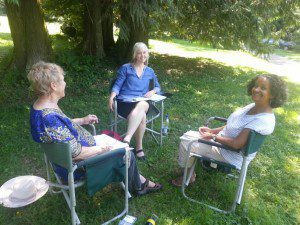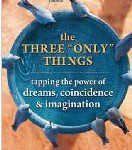 After a lifetime of exploring and sharing dreams, I have invented a fun way to share dreams, get some nonauthoritarian and nonintrusive feedback, and move toward creative action. I call this the Lightning Dreamwork Game. It’s like lightning in two senses — it’s very quick (you can do it in five minutes), and it focuses and brings through terrific energy. It’s a game you can play just about anywhere, with just about anyone – with the stranger in the line at the supermarket checkout, or with the intimate stranger who shares your bed. The rules are simple, and they open a safe space to share even the most sensitive material.
After a lifetime of exploring and sharing dreams, I have invented a fun way to share dreams, get some nonauthoritarian and nonintrusive feedback, and move toward creative action. I call this the Lightning Dreamwork Game. It’s like lightning in two senses — it’s very quick (you can do it in five minutes), and it focuses and brings through terrific energy. It’s a game you can play just about anywhere, with just about anyone – with the stranger in the line at the supermarket checkout, or with the intimate stranger who shares your bed. The rules are simple, and they open a safe space to share even the most sensitive material.
You can play this game with two or more people. We’ll call the principal players the Dreamer and the Partner.
There are four moves in the Lightning Dreamwork Game.
First Move
The Dreamer tells the dream as simply and clearly as possible, as a story. Just the facts of the dream, no background or autobiography. In telling a dream this way, the Dreamer claims the power of the story. The Partner should ask the Dreamer to give the dream report a title, like a story or a movie.
Second Move
The Partner asks the Three Essential Questions. (1) How did you feel? (2) Reality check: What do you recognize from this dream in the rest of your life, and could any part of this dream be played out in the future? (3) What do you want to know about this now?
The Dreamer answers all three questions.
Third Move
The Partner now shares whatever thoughts and associations the dream has triggered for him or her. The Partner begins by saying, “If it were my dream, I would think about such-and-such.” The etiquette is very important. By saying “if it were my dream,” we make it clear that we are not setting out to tell the Dreamer what his or her dream — or life — means. We are not posing as experts of any kind. The Partner is just sharing whatever strikes him or her about the dream, which may include personal memories, other dreams, or things that just pop up. (Those seemingly random pop-ups are often the best.)
Fourth Move
Following the discussion, the Partner asks the Dreamer: What are you going to do now? What action will you take to honor this dream or work with its guidance? If the Dreamer is clueless about what action to take, the Partner will offer his or her own suggestions, which may range from calling the guy up or buying the pink shoes to doing historical or linguistic research to decode odd references. Or, the Dreamer may want to go back inside the dream (see below) to get more information or move beyond a fear. One thing we can do with any dream is to write a personal motto, like a bumper sticker or something that could go on a refrigerator magnet.
Lightning Dreamwork is suitable for almost any group environment. A company manager who had taken one of my trainings introduced her department to the Lightning Dreamwork Game. They found it so much fun — and so helpful in bringing through specific guidance — that the members of her office agreed to devote twenty minutes each morning to sharing dreams as a group. Instead of a diversion of time and energy, the game was highly energizing and the source of creative business solutions as well as personal healing.
Photo: Dream sharing at Mosswood Hollow (c) Robert Moss
–
 Text adapted from The Three “Only” Things: Tapping the Power of Dreams, Coincidence and Imagination by Robert Moss. Published by New World Library.
Text adapted from The Three “Only” Things: Tapping the Power of Dreams, Coincidence and Imagination by Robert Moss. Published by New World Library.

